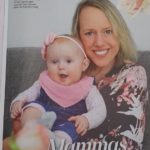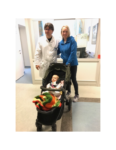Medical Miracle – The Result of a Mother’s Love
 Some risks are worth taking in this story of the Erdheim-Chester Disease miracle baby.
Some risks are worth taking in this story of the Erdheim-Chester Disease miracle baby.
Alice Nilsen, is a 39-year-old Erdheim-Chester Disease (ECD) patient and mother to a beautiful little girl, Marie. Her story to a diagnosis and thereafter, is nothing short of a miracle.
A normal childhood, born in Norway, Alice spent much of her childhood in the United States. She loved figure-skating and gymnastics, among many other sports. After turning 18, Alice moved back to Norway, shortly after she began nursing school to pursue her dreams. This is where Alice’s ECD story began.
Alice became the girl that would always stumble and eventually had trouble even lifting her own feet. Having always been young, healthy, and physically active, this led her primary care doctor to order CT scans of her brain in 2005, the results were inconclusive. Alice would next experience her first MRI; these results were also inconclusive. Referral after referral, doctor after doctor, hospital after hospital, and procedure after procedure, left Alice feeling lost. Nearing four years of medical issues and many procedures, the only thing noticed was the slight buildup on her cerebellum in her brain and a tumor-like spot on her spine. In 2009, doctors, no closer to a diagnosis, decided to biopsy the tumor in her back. Yet again the results were inconclusive, this procedure left Alice with permanent nerve damage, causing her left leg to become numb.
At the time, Alice was a nurse at the psychiatric hospital and watched the years go by with a constant need to urinate, excessive thirst, and a continual decline in her ability to walk. The continual decline left medical professionals perplexed. Many felt that it was an unidentified neurological disease and were close to giving up. What felt like a last attempt at finding answers, Alice was referred to the hospital in Bergen, Norway at the end of 2010.
December 2010, Alice was admitted to the hospital for nearly two weeks doing the same tests over and over. But this time was different. A young Greek doctor, Charalampos Tzoulis, was not willing to give up on Alice or the medical mystery. After the two weeks, he had a suspicion of possible diagnosis. In February 2011, Alice returned to see Dr. Tzoulis, when he performed a spinal bone biopsy near the tumor. The results confirmed his suspicions. After six years of searching for answers, Alice was diagnosed with Diabetes Insipidus and Erdheim-Chester Disease.
The Journey Forward
During the search for a diagnosis, Alice also found love. In 2007, she met Pâl and he has faithfully been by her side since. Relieved from finally getting a diagnosis but also scared of the unknown, Alice and Pâl began searching the internet for answers, support, anything that would help in this new journey. Their search led them to find information on Erdheim-Chester Disease Global Alliance. She quickly reached out to Kathy Brewer, the President and Co-founder of ECD Global Alliance. This connection allowed Alice to not feel so alone. In 2012, Alice and Pâl attended their first ECD Global Alliance Patient and Family Gathering in San Diego, California, meeting expert medical professionals, other patients and caregivers, and the ECD Global Alliance staff.
By now Alice was using walking sticks to maintain her mobility, but upon her return to Norway, she knew that she needed to quit her job as a nurse. The physical demands of the nursing field and Alice’s ability to move around quickly made it illogical to continue. She was, however, able to obtain a new position at the hospital as a secretary. Although a career change was in order, Alice had changes planned for her care.
During the ECD Global Alliance patient and family event in San Diego, Alice had heard about vemurafenib. A new medication that had shown improvement in some patients with ECD. She had been given some medication but with no respite in symptoms. It took some time and persuasion, but Alice told her doctors about the new medication she learned about at the event. In 2013, she was tested for the BRAF mutation. With a quick positive result, Alice began taking vemurafenib in December 2013.
Her initial dose of two vemurafenib in the morning and two in the evening (2 x 2) daily, caused Alice severe pain in her joints and even less mobility. After only three weeks, her Greek doctor reduced her dosage to 1 x 2 daily. The pain became more and more tolerable and after one month on vemurafenib, it was time to see if there were any other visible changes. The scan brought hope and joy! Her doctor told her excitedly that something positive was happening; her tumor was shrinking!
After years of not being able to go to the gym or exercise, the day after she got home from the hospital stay Alice signed up for a gym membership and began walking daily. Her 3-month MRI checkup was even better, then the 6-month visit came with even more good news! Alice continued to push herself at the gym, she even began lifting weights and exercising with a personal trainer. After only one year on vemurafenib, the dosage was reduced again to 1 x 1. After two years, Alice was only taking 1 vemurafenib daily. Her strength kept developing, she even climbed Pulpit Rock, a 600 m climb, with the help of Pål and her two walking sticks in September 2015. One kilometer had become many.
Things were looking up! Alice even attended ECDGA events in Washington D.C., Houston, and Paris. Things were looking good and her walking improved tremendously. Although she knew that she would never walk the same as she did before the original biopsy, she was content! She could now walk longer distances with no help. Exercise became her second medicine, a lifeline to ease the pain.
The Winds of Change
Beginning early in 2017, Alice noticed the constant feeling of exhaustion. Naturally, she believed that she was working too much and even cut back her hours. Still, the fatigue remained. Around Easter, the woman intuition in Alice pushed her to take a pregnancy test. Against all odds, doctors telling her that she would never get pregnant and she should not get pregnant due to the disease, the test was positive. Alice was pregnant. Confirmed by her primary care doctor, Alice was mixed with emotions. She had always wanted to be a mother, so it was a dream come true. On the other hand, with all of her health issues how would it ever work. She knew that the call to Dr. Tzoulis would be tough. He did not share in her excitement and suggested abortion. He was worried that the time Alice had spent on vemurafenib while pregnant, which was three months, could cause the unborn baby malformations or other health issues.
At 18 weeks pregnant, Alice and Pâl went for their very first ultrasound! The baby was doing great with no apparent side-effects from the vemurafenib. This made their decision even harder to even ponder, but they decided to continue with the pregnancy and welcome a new life to their family. This new adventure brought new trials. From the moment she found out she was pregnant she no longer took the vemurafenib. Alice and Pâl waited anxiously at each ultrasound, but each time the little one was growing strong and healthy. Alice, on the other hand, was quickly getting worse. Her walking quickly declined. First it was crutches, then a walking-chair, next, the wheelchair. Her weight decreased and she began experiencing shortness of breath with only the slightest of movements. Work was no longer a feasible option for Alice, she began sick leave in May 2017.
Dr. Tzoulis became worried as Pâl wheeled Alice into his office in September 2017. She had no strength left. Quickly Dr. Tzoulis called her obstetrician to ask if birth could start soon. Much to the surprise of some, the doctors heard that she may recover faster with a natural birth. So, that was the plan. The following Sunday, Alice and Pâl were at the hospital to start the birth with Pitocin.
The Sunshine After the Storm
On Wednesday, September 27, 2017, Alice gave birth to a perfect and beautiful baby girl, Marie. With Marie being here and healthy and Alice having an uncomplicated natural birth, her doctors wasted no time getting back to treating the ECD. The day after delivery, Alice had an MRI to assess the damage the months of no treatment had caused. It looked terrible, new lesions were visible in the scan. She was immediately put back on vemurafenib, but no one knew if it would be successful this time around.
Seemingly against the odds, the vemurafenib was working. At her three and six-month check-ups Dr. Tzoulis reported drastic changes in the scans. She is slowly getting better with the medication, daily exercise, physical therapy, and her natural love and drive for wellness.
Alice’s drive for health and love for Marie has only facilitated her physical condition. “Marie is the best thing that has happened to me. Always smiling, she brightens my day,” Alice beams.
As of her latest check-up on August 23, 2018, a mere 11-months after giving birth to Marie, the ECD is inactive! Alice said, “Pål, Marie and I are now a little family, something I thought would never happen. Marie will not know how special she is until she grows older.”
Never give up hope.









